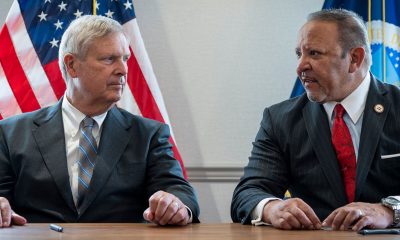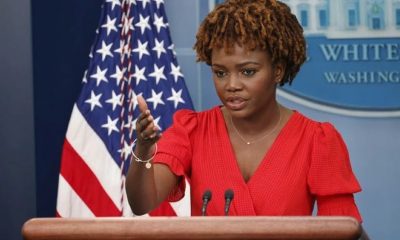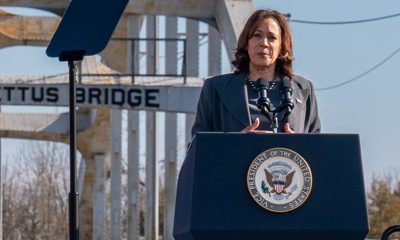Black History
Inspired by MLK to make difference through love: Clara Ester
NASHVILLE PRIDE — That day at the Lorraine Motel shaped her ministry.
By Joe Lovino
“I have come to grips many, many, many years ago that only through love can we make a difference,” said United Methodist deaconess Clara Ester.
“We can actually change things if we love.”
Ester learned this important lesson from the Rev. Martin Luther King, Jr., leader of the Civil Rights Movement in the United States.
“Love takes a lot of effort and work,” Ester said, “but that’s the way God wants us to go, and that was the life that Dr. King led.”
“Being clergy he knew the importance of love,” Ester said, “and he wanted to deal with major issues and concerns that people were going through in a justice way. But he did it through love and nonviolence. That was his life.”
Growing up in Centenary Methodist Episcopal Church in Memphis, Tennessee, then pastored by civil rights leader Rev. James Lawson, Ester saw a connection between King and her faith.
“He led the life and stood up for things like Jesus did when he was on earth,” she said. “The marginalized people were the people Jesus hung out with. People that were not your favorite folks to be around were folks you found Jesus with. Dr. King stood up and spoke out for the same marginalized people. He tried to change structures that would make that world better.”
Ester hadn’t always seen things that way. “I had a lot of hate within me when I saw how people could be treated,” she said. Love and nonviolence seemed a slow way to affect change.
“I was a junior in college,” Ester said. “I heard both sides. But being young, 19 or 20 years old, I wanted everything to end as rapidly as possible.”
On the evening of April 4, 1968, things changed. Ester had just arrived at the Lorraine Motel when King came out of his room and started talking to people in the parking lot. A shot rang out. King’s assassination was a turning point for Ester.
“Witnessing his death, seeing him on that balcony, hearing him the night before say: ‘I may not get there with you, but we as a people will make it to the Promised Land.’ Recognizing more and more about his commitment to the nonviolent process. There was something about being over his body that said, ‘You need to change your hate. You need to love.’”
Reflecting on the call to love our neighbors, Ester references Jesus’ parable of the Good Samaritan where a man is mugged and left by the side of the road (Luke 10:25-37). Two religious leaders approach, and Jesus’ first listeners would have expected them to be the people to do something—but they each cross the street to avoid the injured man. The third person who comes down the road is a Samaritan.
This is not the person anyone would have expected to help out. The gospel of John tells us “Jews and Samaritans didn’t associate with each other” (John 4:9). Yet in Jesus’ story the Samaritan goes to extraordinary lengths to care for this stranger.
After concluding the parable, Jesus tells those who’ve head the story, “Go and do likewise.” On the balcony that day, Ester heard that same call.
“Witnessing his death made me recognize that I had a responsibility not to ever step over anybody, or walk on the other side of the road. If there were people that I was aware of on the path that I was going, I had a God-assigned responsibility to reach out and try to help make their world better.
“That’s where we all should be. If we all did that through love and compassion, we would be living in a greater society than we live in today.”
Immediately following King’s assassination, Ester left college. She went to Marks, Mississippi to work on the second Poor People’s Campaign, a march from Mississippi to Washington, D.C. planned by King. Marks was chosen because it was considered “the poorest town in the poorest county of the poorest state in the nation” (Mississippi Stories).
Later, Ester would return to school and finish her degree. She served as a deaconess in The United Methodist Church, working for people in need throughout her career. In 2006, she retired as executive director of Dumas Wesley Community Center, a mission institution in Mobile, Alabama supported by the United Methodist Women. Today Ester serves as national vice president of the United Methodist Women.
That day at the Lorraine Motel shaped her ministry.
“This man was willing to love until this moment when a bullet took his life. He was willing to work and stand up and fight in a nonviolent way,” she said. “That was the least that I could do.
“After that, it was strictly nothing but, ‘What can I do to help somebody else? What can I do to make life better? What can I do or what can I give to change the narrative of what’s taking place in this person’s life today?’ It was a turning point in my personal life for me to reflect on the direction I could have been in, and the direction I needed to go.”
This article originally appeared in the Nashville Pride.
Activism
Oakland Post: Week of April 17 – 23, 2024
The printed Weekly Edition of the Oakland Post: Week of April 17 – 23, 2024

To enlarge your view of this issue, use the slider, magnifying glass icon or full page icon in the lower right corner of the browser window. ![]()
Black History
Matthew Henson: Explorer Extraordinaire
Matthew Henson, a trailblazing explorer who overcame countless obstacles to leave an incredible mark on history. Born on August 8, 1866, in Charles County, Maryland, his journey is a testament to the power of determination and the spirit of adventure.

By Tamara Shiloh
Matthew Henson, a trailblazing explorer who overcame countless obstacles to leave an incredible mark on history. Born on August 8, 1866, in Charles County, Maryland, his journey is a testament to the power of determination and the spirit of adventure.
Henson’s life began amidst the backdrop of post-Civil War America, where opportunities for African Americans were scarce. From a young age, he possessed an insatiable curiosity about the world beyond his small town. At the age of 12, he embarked on a journey that would change the course of his life forever when he joined a merchant ship as a cabin boy.
His most famous expedition was his journey to the Arctic with renowned explorer Robert E. Peary. In 1887, Henson joined Peary’s crew as a seaman and quickly proved himself to be invaluable with his skills as a navigator and craftsman. Over the course of several expeditions, Matthew endured extreme cold, treacherous terrain, and grueling conditions as he and Peary sought to reach the elusive North Pole.
In 1908–09, Peary set out on his eighth attempt to reach the North Pole. It was a big expedition, with Peary planning to leave supplies along the way. When he and Henson boarded their ship, the Roosevelt, leaving Greenland on August 18, 1909, they were joined by a large group. This included 22 Inuit men, 17 Inuit women, 10 children, 246 dogs, 70 tons of whale meat, blubber from 50 walruses, hunting gear, and tons of coal.
In February, Henson and Peary left their anchored ship at Ellesmere Island’s Cape Sheridan, along with the Inuit men and 130 dogs. They worked together to set up a trail and supplies along the way to the Pole.
Peary picked Henson and four Inuit people to join him in the final push to the Pole. However, before they reached their destination, Peary couldn’t walk anymore and had to ride in a dog sled. He sent Henson ahead to scout the way. In a later interview with a newspaper, Henson recalled being in the lead and realizing they had gone too far. The group turned back, and Henson noticed his footprints helped guide them to their destination. At that location, Henson planted the American flag.
Henson’s legacy extends far beyond his expeditions to the Arctic. He shattered racial barriers in the world of exploration and inspired countless individuals, regardless of race, to dream big and pursue their passions. In 1937, he was finally recognized for his achievements when he was inducted into The Explorers Club, an organization dedicated to promoting scientific exploration and field research.
Matthew Henson died in the Bronx, New York, on March 9, 1955, at the age of 88.
Art
Marin County: A Snapshot of California’s Black History Is on Display
The Marin County Office of Education, located at 1111 Las Gallinas Ave in San Rafael, will host the extraordinary exhibit, “The Legacy of Marin City: A California Black History Story (1942-1960),” from Feb. 1 to May 31, 2024. The interactive, historical, and immersive exhibit featuring memorabilia from Black shipyard workers who migrated from the South to the West Coast to work at the Marinship shipyard will provide an enriching experience for students and school staff. Community organizations will also be invited to tour the exhibit.

By Post Staff
The Marin County Office of Education, located at 1111 Las Gallinas Ave in San Rafael, will host the extraordinary exhibit, “The Legacy of Marin City: A California Black History Story (1942-1960),” from Feb. 1 to May 31, 2024.
The interactive, historical, and immersive exhibit featuring memorabilia from Black shipyard workers who migrated from the South to the West Coast to work at the Marinship shipyard will provide an enriching experience for students and school staff. Community organizations will also be invited to tour the exhibit.
All will have the opportunity to visit and be guided by its curator Felecia Gaston.
The exhibit will include photographs, articles and artifacts about the Black experience in Marin City from 1942 to 1960 from the Felecia Gaston Collection, the Anne T. Kent California Room Collection, The Ruth Marion and Pirkle Jones Collection, The Bancroft Library, and the Daniel Ruark Collection.
It also features contemporary original artwork by Chuck D of the Rock and Roll Hall of Fame group Public Enemy, clay sculptures by San Francisco-based artist Kaytea Petro, and art pieces made by Marin City youth in collaboration with Lynn Sondag, Associate Professor of Art at Dominican University of California.
The exhibit explores how Marin City residents endured housing inequities over the years and captures the history of plans to remove Black residents from the area after World War II. Throughout, it embodies the spirit of survival and endurance that emboldened the people who made Marin City home.
Felecia Gaston is the author of the commemorative book, ‘A Brand New Start…This is Home: The Story of World War II Marinship and the Legacy of Marin City.’ Thanks to the generous contribution of benefactors, a set of Felecia’s book will be placed in every public elementary, middle, and high school library in Marin.
In addition, educators and librarians at each school will have the opportunity to engage with Felecia in a review of best practices for utilizing the valuable primary sources within the book.
“Our goal is to provide students with the opportunity to learn from these significant and historical contributions to Marin County, California, and the United States,” said John Carroll, Marin County Superintendent of Schools.
“By engaging with Felecia’s book and then visiting the exhibit, students will be able to further connect their knowledge and gain a deeper understanding of this significant historical period,” Carroll continued.
Felecia Gaston adds, “The Marin County Office of Education’s decision to bring the Marin City Historical Traveling Exhibit and publication, ‘A Brand New Start…This is Home’ to young students is intentional and plays a substantial role in the educational world. It is imperative that our community knows the contributions of Marin City Black residents to Marin County. Our youth are best placed to lead this transformation.”
The Marin County Office of Education will host an Open House Reception of the exhibit’s debut on Feb. 1 from 4 p.m. – 6 p.m.. All school staff, educators, librarians, and community members are encouraged to attend to preview the exhibit and connect with Felecia Gaston. To contact Gaston, email MarinCityLegacy@marinschools.org
-

 Activism4 weeks ago
Activism4 weeks agoOakland Post: Week of March 27 – April 2, 2024
-

 #NNPA BlackPress4 weeks ago
#NNPA BlackPress4 weeks agoCOMMENTARY: D.C. Crime Bill Fails to Address Root Causes of Violence and Incarceration
-

 #NNPA BlackPress4 weeks ago
#NNPA BlackPress4 weeks agoFrom Raids to Revelations: The Dark Turn in Sean ‘Diddy’ Combs’ Saga
-

 #NNPA BlackPress4 weeks ago
#NNPA BlackPress4 weeks agoCOMMENTARY: Lady Day and The Lights!
-

 #NNPA BlackPress4 weeks ago
#NNPA BlackPress4 weeks agoMayor, City Council President React to May 31 Closing of Birmingham-Southern College
-

 #NNPA BlackPress4 weeks ago
#NNPA BlackPress4 weeks agoBaltimore Key Bridge Catastrophe: A City’s Heartbreak and a Nation’s Alarm
-

 #NNPA BlackPress4 weeks ago
#NNPA BlackPress4 weeks agoBaltimore’s Key Bridge Struck by Ship, Collapses into Water
-

 #NNPA BlackPress4 weeks ago
#NNPA BlackPress4 weeks agoBeloved Actor and Activist Louis Cameron Gossett Jr. Dies at 87



















































